Massive stars, like the Pistol Star, one of the most luminous known stars in the Milky Way Galaxy, are the likely sources of the observed gamma-rays from the isotope iron-60, recently discovered by astronomers.
Stars like this giant have 80 to 150 times the mass of the Sun and "lifetimes" of about 3 million years. Unlike ordinary stars, they are strongly affected by outward pressure of the light that they emit. They also pervade and shape our galaxy.
After a long search, the radioactive isotope iron-60 has finally been found drifting in space, so ESA's orbiting gamma-ray observatory, Integral, has made a pioneering unequivocal discovery. The isotope was discovered following an enhancement in gamma rays at two characteristic energies, 1173 and 1333 kilo electron Volts, found in the galaxy.
Roland Diehl of the Max-Planck-Institut f?r extraterrestrische Physik, headed the work and believes it is a major step forward. "These gamma-ray lines have been detected before with some dispute. Integral, the only instrument capable of doing this, shows that iron-60 does exist in interstellar space in our Galaxy," he says.
This process is known to be caused by iron-60 decaying into cobalt-60 and could provide vital insights into the workings of the most massive stars in the galaxy, and not only. Most chemical elements are built inside stars from raw ingredients present during star formation from an interstellar gas cloud.
This interstellar gas contained hydrogen and helium produced by the Big Bang but also some enrichments, known to astronomers as "metals", from previous generations of stars and their nuclear reactions.
Deep inside a massive star, iron-60 is synthesized from pre-existing stable iron isotopes by a process called "neutron capture" and it's only detected in space when the star explodes at the end of its life. The problem is iron-60 has a half-life of 1.5 million years and only this decay produces the gamma rays that ESA's Integral detected.
"Iron-60 provides the entry into studying neutron capture in stars through contemporaneous radioactivity," says Diehl.

 14 DAY TRIAL //
14 DAY TRIAL //